A comparative overview is given, focussing on different boarding procedures/strategies and infrastructural changes to improve the aircraft boarding. Therefore, the stochastic boarding model is extended to the requirements of new operations and infrastructures (e.g. innovative seat configurations). Different concepts impacting the aircraft boarding process are evaluated: different boarding strategies (chronological order of passengers), hand luggage (amount, distribution, and chronological order), group constellations, the Flying Carpet concept, and dynamic seat configurations of Side-Slip Seat and Foldable Passenger Seat. The list of publications can be found here: references.
Operations: boarding from back to front
To model different boarding strategies and operations, the introduced grid-based ASEP approach enables an individual allocation of seats as well as an aggregation of seats to specific blocks according to specific boarding strategies. Six different boarding strategies are addressed: random, back-to-front, optimized block, outside-in, reverse pyramid, and individual seating. For the random boarding, passengers arrive with no specific chronological order. The back-to-front and the optimized block strategies consist of specific boarding blocks with different block sizes and order: back-to-front has two blocks and the rear block is boarded first, whilst the optimized block strategy has six blocks, which are alternately boarded (starting with the second last block). For the outside-in strategy, the seats are grouped into three blocks, which separate the window, middle, and aisle seats. Here, the window seats are boarded first, followed by the middle and the aisle seats. The reverse pyramid strategy is a hybrid approach of back-to-front and outside-in boarding and consists of eight blocks. Finally, the individual boarding strategy is a specific solution of the optimized block, since in this case, each block contains only one seat.
A familiar boarding procedure is a back-to-front strategy, which is operationally applied at some airlines. For this strategy, seat rows are aggregated to seat blocks and these blocks are called at the beginning of the boarding. The efficiency of the back-to-front strategy depends on the size of the blocks. The following figure demonstrates that two blocks and three blocks shorten the boarding time by 4.1% and 2.0% respectively, but a higher number of blocks will not improve boarding operations. The relative standard deviation (RSD) decreases from reference value (7.3%) to 7.1% using two blocks and is unchanged at 7.3% using three blocks for boarding. Considering the fact that back-to-front boarding is not efficient using more than three blocks, the optimized block strategy demonstrates better performance. This strategy is still based on a back-to-front approach but calls the even blocks first and the odd blocks second, or vice versa. The right diagram shows the improvement of the boarding time and relative standard deviation for block sizes higher than four. Finally, boarding operations benefit from the optimized/alternating approach by a boarding time reduction of 11.2 % using 15 blocks (two rows in each block, the last block contains only one row). The RSD value shows a contrary behavior with a decrease for back-to-front and a slight increase in the optimized block strategy.
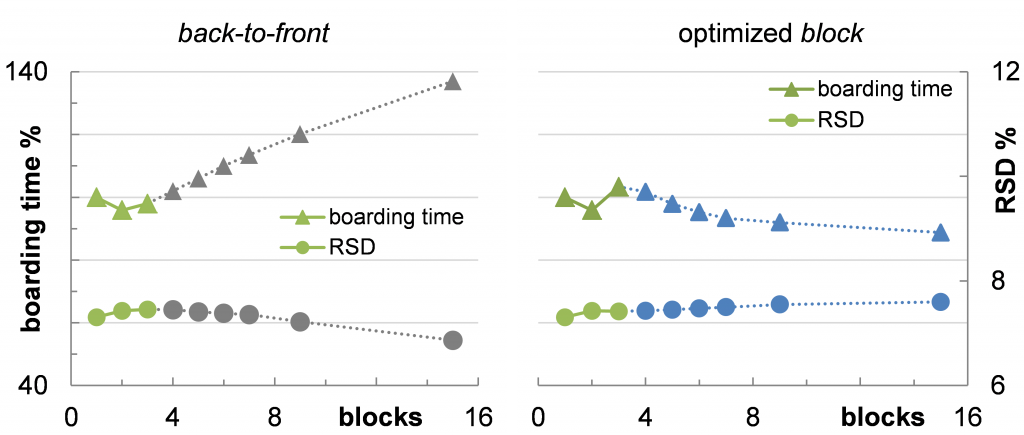
Conformance and arrival rate
In the next evaluation, a sensitivity analysis is applied with regards to the model parameter of passenger conformance to boarding strategy and passenger arrival rate at the aircraft. In the following figures, the boarding strategies are grouped, using different colors to indicate the random reference (black), strategies based on seat rows (blue), strategies based on lateral seat position (green), and individual boarding sequence. The conformance rate describes the fact that a boarding strategy demands a specific chronological order of passengers (more precise: seats), but this order could only be realized up to a certain level: passengers may arrive late from prior flights (airside connection) or security control (landside connection), privileged passengers could board at any time, or families (groups) will not be separated. It is expected that these disturbances will reduce the effectiveness of the boarding strategies. The arrival rate is defined as the average number of passengers per minute arriving at the aircraft door and is modeled as a stochastic process with exponentially distributed interarrival times. The boarding times decrease with an increasing arrival rate and reach specific time levels depending on the boarding strategy, at which the boarding times could not be significantly reduced any more (convergence).

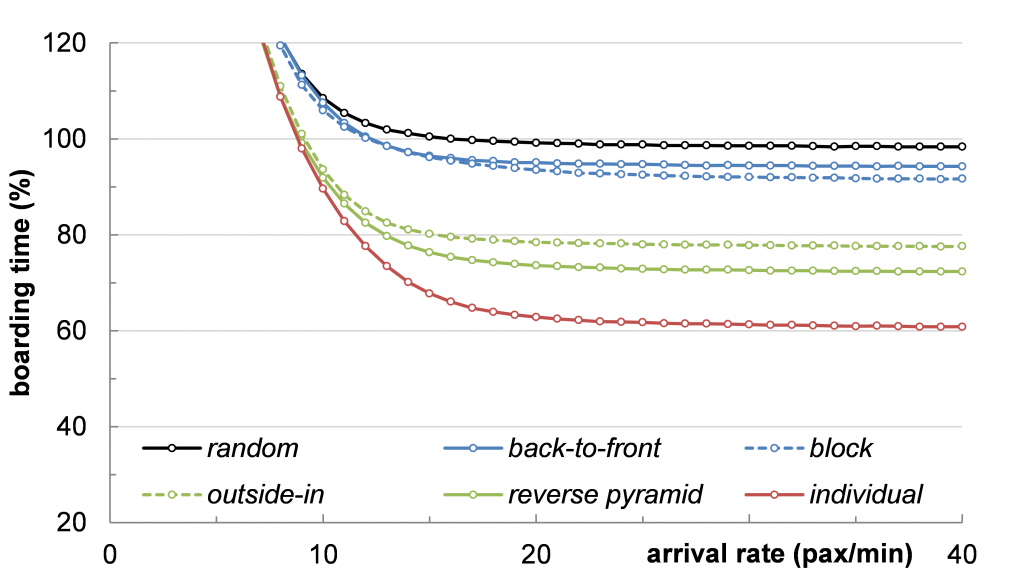
Hand luggage and passenger groups
Frequently arising statements are that passengers with no hand luggage will immediately result in faster boarding operations and that a large amount of hand luggage leads to blocked overhead compartments with counterflow conditions in the aircraft aisle, which extend the boarding process significantly. From the operational point of view, hand luggage constraints will have a negative impact on the passengers’ individually perceived level of service and come along with a need for an efficient parallel baggage handling process (including baggage drop, loading, and reclaim). The following figure shows a reduction of boarding time if the number of items is reduced from 1.5 items per passenger as average to zero.
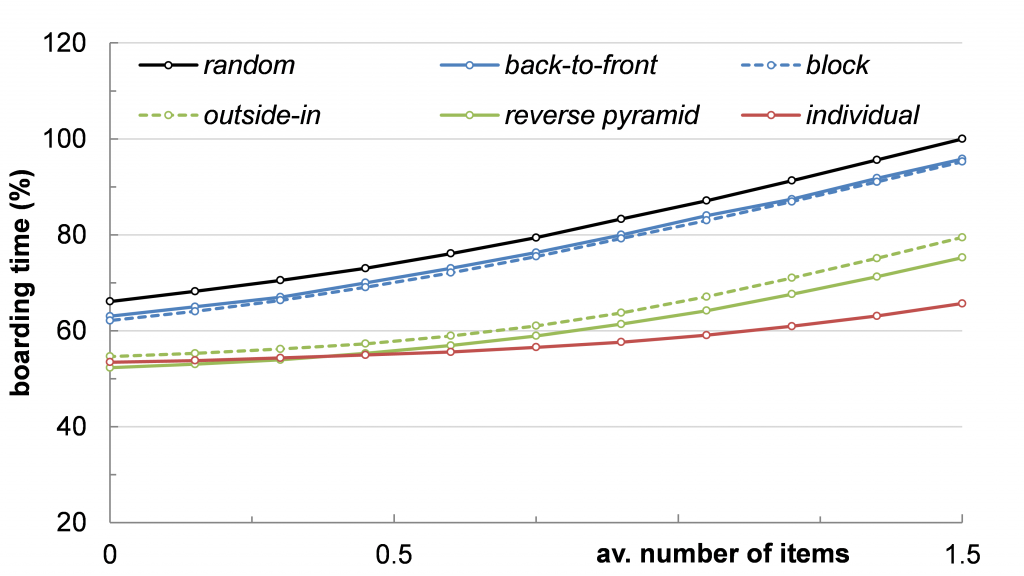
The number of passengers traveling in a group differs between business and tourist passengers. Whereas business passengers tend to travel alone (73% alone), tourists are organized more in groups (19% alone). To model the effect of grouped passengers, different groups of passengers are evaluated, assuming that the group members will always sit together at one side of a seat row, in full rows, or on one side in the following rows. The benefit of group boarding is caused by the fact that group members are boarded at the same time and reduce their interdependencies during the seating process by themselves. It is assumed that they choose the most convenient sequence to enter the seat row (no seat shuffle). Thus, the member sitting in the window (middle) seat will enter before the middle- (aisle-) seating member. This behavior generally mitigates unfavorable seat conditions and the negative impact on the subsequently following passengers. In the following figure (left) the effect of a group of two passengers is shown with an increasing rate of groups in the aircraft cabin. With a focus on specific group constellation, an average ratio of 30% is exemplarily used to emphasize the impact of groups on the boarding time (right figure). A ratio of 30% at seat load of 85% means that approx. 44 pax are part of a group. In the stochastic boarding approach, the ratio of 30% is modeled by a random process, whereas in each simulation run, the ratio is transferred a specific probability for each pax to be part of a group. The exemplary evaluation is based on six specific group constellations: 2 pax, 3 pax, 6 pax sitting in one row, 6 pax sitting on one side of the aircraft in sequenced rows, 9 pax sitting on one side of the aircraft in sequenced rows, and 12 pax sitting in two sequenced rows. These constellations lead to an average number of groups of 22, 15, 7, 5, and 4.
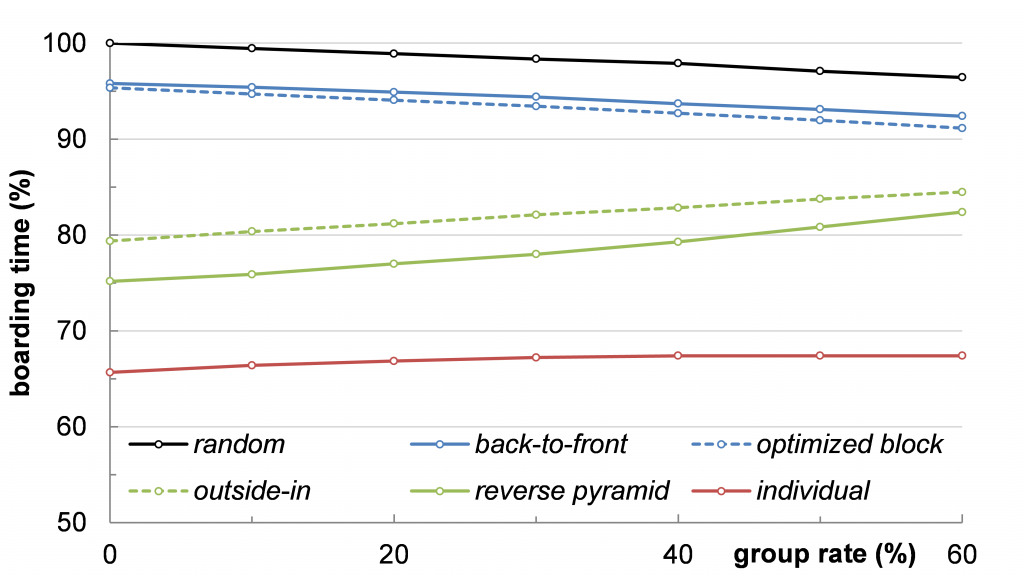
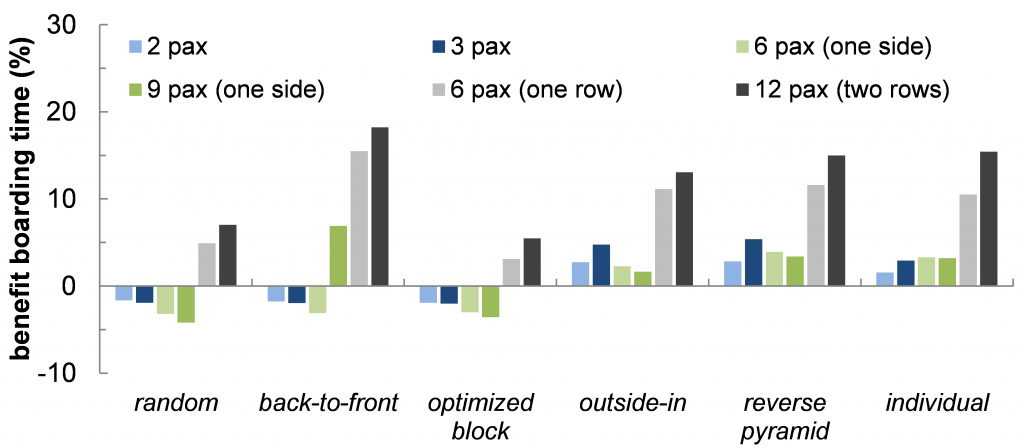
Infrastructural changes
Standard approaches to accelerating aircraft boarding mainly address the management of passenger behavior by providing airline-specific boarding sequences or hand luggage regulation. A first, straightforward approach of sufficient use of the boarding infrastructure is the application of the rear aircraft door. Since this approach usually incorporates both an apron position of the aircraft and a bus shuttle transfer (or walk boarding), it counteracts the idea of an optimized chronological order of passengers (sequence will dissipate). Nevertheless, the use of the rear door results in substantially faster boarding times, even assuming a random boarding scenario.
The concept of the Flying Carpet is based on the idea that a batch of pax (up to 40) will be sorted after passing the boarding gate by providing an aircraft seat layout on the floor in a separate area on the way to the aircraft. Passengers entering the area walk to their specific seat position, which is marked on the floor, and wait there until a handling agent releases the batch of pax. This procedure allows for an efficient pre-sorting with regards to both lateral seat position (window, middle, aisle) and row position (last rows first). Six different batch sizes are evaluated, with an average size of 10, 15, 20, 25, 30, and 35 pax and an equality distributed bandwidth of ±5 pax. The application of the Flying Carpet with a batch size of 20-30 pax could reduce the boarding time by 35%. Even small batch sizes, such as 5-15 pax, reduce the boarding time significantly (22%).
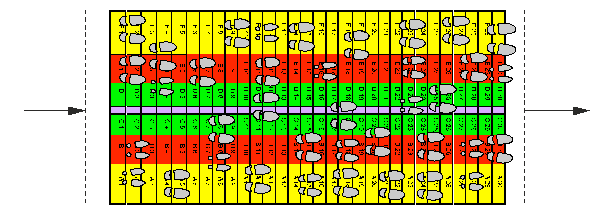
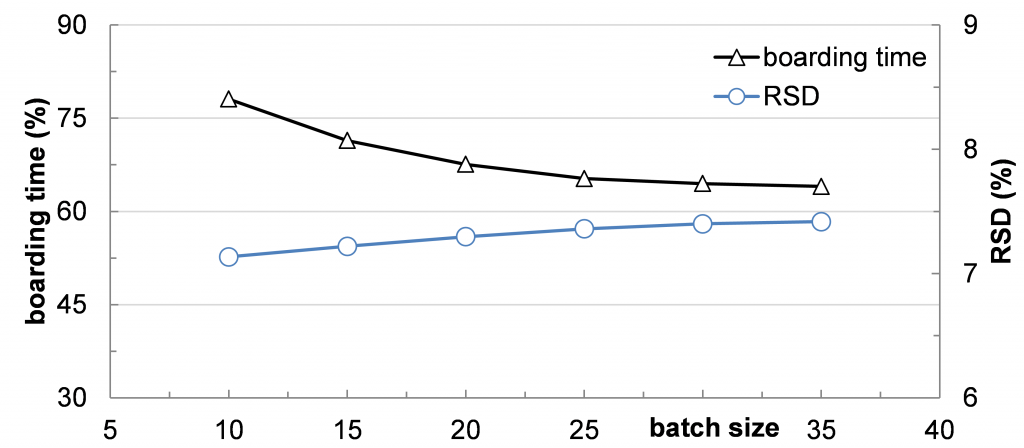
The approach of a Side-Slip Seat from Molon Labe Seating dynamically changes the aircraft cabin infrastructure, supporting the boarding operations by providing an extra space to allow two passengers to pass each other in a convenient way. The innovative seat design allows the aisle seat to be moved in the direction of the middle seat (staggered, folded position). Aisle seats will be in this initial position (folded) until passengers want to access middle or aisle seats. Thus, passengers can easily slide the aisle seat out of the initial position (and back) and lock the seat in the “flight ready” position. The stochastic boarding model and simulation environment are appropriately adapted to allow movements of two passengers in the aisle. Furthermore, the dynamic status of the seat row (folded/unfolded) is implemented to enable/disable the parallel movement of two passengers. The following figures demonstrate the operational principle: passengers can pass the orange passenger at row three on the left side, while this passenger stores the hand luggage items and takes the seat on the right window seat in the third row.

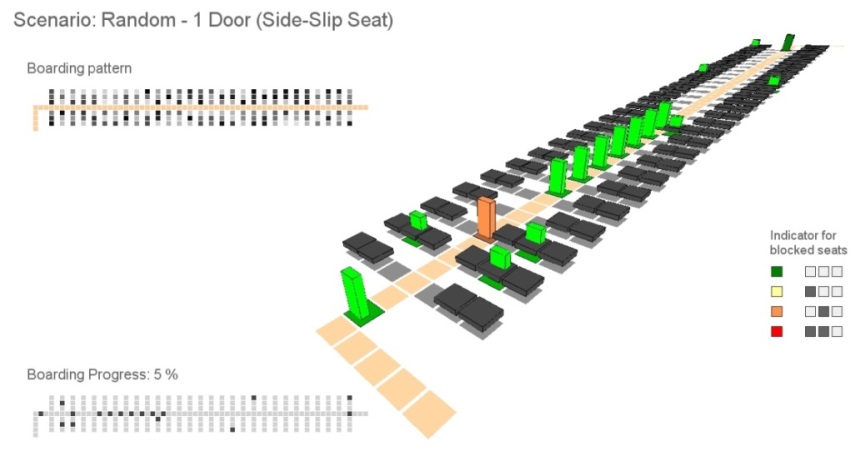
To evaluate the benefit of the Side-Slip Seat configuration, the introduced boarding strategies are evaluated for the one-door and two-door operations. Each evaluated boarding strategy benefits considerably from this significant infrastructural change and provides a faster boarding than the foldable passenger seat. As with the Side-Slip Seat, the innovative concept of a Folded Passenger Seat from SII Group also efficiently adapts the aircraft cabin. The seat provides a folded position for the aisle seat, where the seating surface could be tipped up like a cinema seat. This concept enables passengers to pass each other if the aisle seat of the corresponding seat row is free during the hand luggage storage progress.
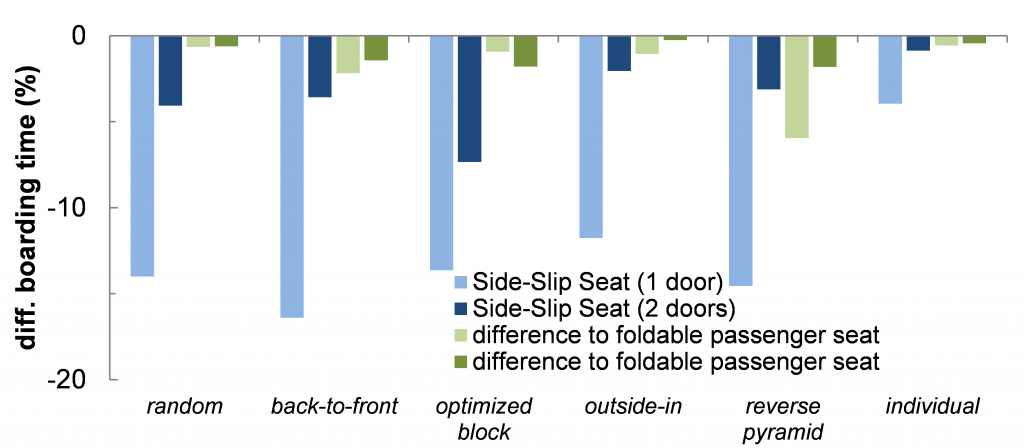
References
- Michael Schultz, Michael Schmidt (2018). Advancements in passenger processes at airports – An aircraft perspective
- Michael Schultz (2018). Fast aircraft turnaround enabled by reliable passenger boarding
- Michael Schultz (2017). Faster aircraft boarding enabled by infrastructural changes
- Michael Schultz (2017). Passenger Boarding – Model and Operations (ATRS Conference)
- Michael Schultz (2017). Aircraft Boarding – Data, Validation, Analysis
- Michael Schultz, Thomas Kunze, Hartmut Fricke (2013). Boarding on the critical path of the turnaround
- Michael Schultz, Christian Schulz, Hartmut Fricke (2008). Efficiency of Aircraft Boarding Procedures
The complete list of publications can be found here: references.
